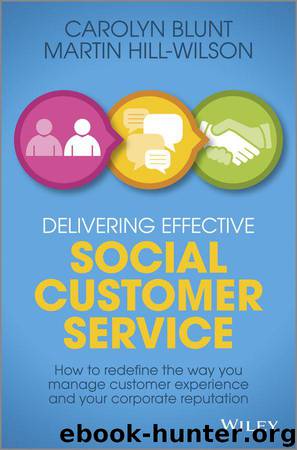Delivering Effective Social Customer Service: How to Redefine the Way You Manage Customer Experience and Your Corporate Reputation by Martin Hill-Wilson & Carolyn Blunt

Author:Martin Hill-Wilson & Carolyn Blunt [Hill-Wilson, Martin]
Language: eng
Format: mobi
Publisher: Wiley
Published: 2013-10-22T14:00:00+00:00
Bian Salins – Head of Social in the TV & Media industry. Previously Head of Social for a Telcoms company
This is how the so-called “super users” arise. When this behaviour is deployed in a service context, an entirely new kind of issue resolution takes place. Take giffgaff, the SIM only UK mobile brand. Vincent Boon, their community manager, summed up the dynamic like this:
“Our super users are spending upwards of 170 hours a month helping the community to answer questions and assisting people migrating onto our service. Some giffgaffers even spent over nine hours a day helping people.”
Source: Lithium giffgaff Case Study Using Community to Build an Entirely New Kind of Company 2011
Of course it takes skill and commitment to develop this level of involvement. Community managers will tell you there is no such thing as treading water. You are either expanding or contracting in perceived value. There is much to be done making a community tick.
That said, advocates of the peer-to-peer support model claim the approach is faster, cheaper and often more effective in terms of first time resolution and quality of generated knowledge relative to traditional Customer Service strategies. Naturally customer satisfaction, however, measured, also trends higher than average.
However, it is important to be clear when peer-to-peer works best. For instance classic Customer Service issues such as stock availability or delivery issues should still be answered by an organization's employees. They have the relevant data.
The value of customer involvement comes into its own around topics they really understand. How a product is actually used. This is always something that designers, manufacturers and retailers of products have comparatively little insight into once customers have purchased. How their products or services are actually used or consumed in daily life disappears from view.
This is where customers become the experts. They use it, abuse it, re-invent it, take it apart, find the things that don't work. Notice the things that should be there. In other words their community value extends from simple fixes to what is sometimes called “ideation” – creative input for your product roadmap.
In fact, the more complex your product, the more valuable this type of input becomes.
For instance, brands that offer complex software have long understood it is their customers who drive the value. They discover how the software works in practice, what it enables, how to get around the shortcuts of the current release, what best practice looks like.
Vendors such as SAP, Microsoft, and Autodesk have learned how to get out of the way and let their customers network, share expertise and learn from each other. As testament to their value, some of these communities have membership in the hundreds of thousands, occasionally in the millions.
They work because it is a deep human instinct to use communities and be part of them. In fact, this current phase of internet evolution is just that. The so-called “social web” is all about experimenting with community dynamics such as accelerating innovation, socializing issues, spreading ideas, extending influence.
One of the interesting trends
Download
This site does not store any files on its server. We only index and link to content provided by other sites. Please contact the content providers to delete copyright contents if any and email us, we'll remove relevant links or contents immediately.
Bad Blood by John Carreyrou(6274)
Rich Dad Poor Dad by Robert T. Kiyosaki(6174)
Principles: Life and Work by Ray Dalio(5960)
Playing to Win_ How Strategy Really Works by A.G. Lafley & Roger L. Martin(5496)
Management Strategies for the Cloud Revolution: How Cloud Computing Is Transforming Business and Why You Can't Afford to Be Left Behind by Charles Babcock(4438)
The Confidence Code by Katty Kay(4036)
Thinking in Bets by Annie Duke(3996)
American Kingpin by Nick Bilton(3507)
Delivering Happiness by Tony Hsieh(3280)
Project Animal Farm: An Accidental Journey into the Secret World of Farming and the Truth About Our Food by Sonia Faruqi(3016)
The Power of Habit by Charles Duhigg(2966)
Brotopia by Emily Chang(2892)
Mastering Bitcoin: Programming the Open Blockchain by Andreas M. Antonopoulos(2891)
The Tyranny of Metrics by Jerry Z. Muller(2846)
I Live in the Future & Here's How It Works by Nick Bilton(2844)
The Marketing Plan Handbook: Develop Big-Picture Marketing Plans for Pennies on the Dollar by Robert W. Bly(2792)
The Content Trap by Bharat Anand(2778)
Building a StoryBrand by Donald Miller(2754)
Applied Empathy by Michael Ventura(2749)
